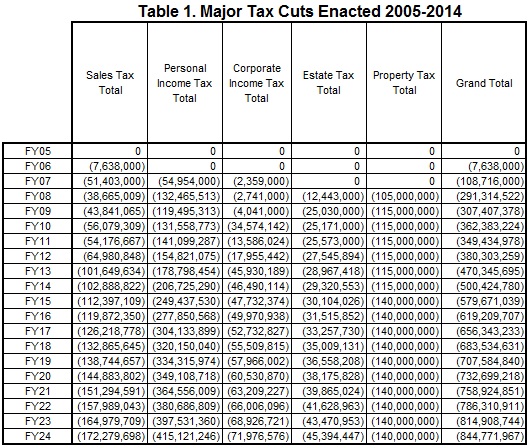Policy brief: Legislature has reduced taxes significantly in past decade
As the Legislature starts to discuss tax policy measures during full-day debates, it’s good to remember that lawmakers have enacted several significant tax reductions over the last decade.
The reductions have been for all kinds of taxes but most major tax-cut legislation since 2005 has focused on income taxes. Major tax cut packages enacted in 2005-2014 are already providing nearly $580 million in tax reductions in Fiscal Year 2014-2015 (FY15), with income tax cuts accounting for $297 million of those reductions (Table 1). The value of these tax reductions is projected to exceed $840 million per year by FY24 with income tax cuts accounting for $487 million of those reductions.
By FY24, 58 percent of the reduced revenue will come from income tax reductions, 20 percent from sales tax reductions, 17 percent from property tax reductions and 5 percent from estate tax reductions.
The tax reductions already have decreased revenue available to support education and other services and contributed to our growing reliance on property taxes to fund these critical services. Our reliance on property taxes only stands to increase as the effect of the tax reductions grows over time.
Looking back at the bills
Below we look closer at some of the major tax reduction legislation enacted since 2005. A table showing a year-by-year breakdown of each of these changes can be found at the end of this analysis.
This analysis focuses on major tax packages and rate and bracket changes enacted in 2005-14. It does not include all tax policy changes over the past decade. For example, the Legislature’s 2007 decision to tax agricultural land at 75 percent of market value instead of 80 percent is not included, as the property tax effects are indeterminate.
(* denotes income tax reductions.)
LB 312* (2005)
LB 312 created the Nebraska Advantage Act, a business incentive package through which businesses can earn tax credits and exemptions against income, sales and property taxes by increasing investment and employment in Nebraska. Nebraska Advantage usage reduced revenue by nearly $120 million in FY15. The revenue reduction is projected to reach nearly $181 million per year by FY24.
LB 968* (2006)
LB 968 expanded individual income tax brackets, expanded deductions and credits for high-income earners, created the Nebraska Earned Income Tax Credit (EITC) and re-instated sales tax exemptions for certain contractor labor. LB 968 reduced state revenue by $105 million in FY15 and is projected to reduce revenue almost $159 million per year by FY24.
LB 367* (2007)
LB 367 eliminated the estate tax, created the Property Tax Credit program, eliminated the income tax “marriage penalty,” increased standard deductions and coupled to federal amounts, expanded the EITC and exempted commercial contractor labor and wind energy projects from sales tax. LB 367 provided $248 million in tax reductions in FY15 and is projected to reduce taxes by more than $315 million per year by FY24.
LB 888* (2008)
LB 888 increased the cut-off for the top corporate income tax bracket from $50,000 to $100,000. LB 888 reduced revenue by $3 million in FY15 and is projected to reduce revenue by $4.7 million annually by FY24.
LB 970* (2012)
LB 970 expanded individual income tax brackets and reduced rates in the bottom three brackets. The bill provided $55.6 million in tax reductions in FY15 and the revenue reduction is expected to reach $84 million per year by FY24.
LB 308* (2013)
LB 308 eliminated the Alternative Minimum Tax — which helped ensure that some high-income earners who qualified for several credits and deductions paid at least a minimum amount of income tax. LB 308 resulted in $7.8 million in reduced revenue in FY15, and is projected reduce revenue by $11.4 million by FY24.
LB 96, LB 987* and LB 905 (2014)
Lawmakers in 2014 passed three major tax reductions after a study of the tax code.
LB 96 exempted agricultural machinery and repair parts from sales tax. It reduced revenue $6.8 million in FY15 and will result in $13 million in reduced revenue by FY24.
LB 987 indexed Nebraska’s income tax brackets for inflation and exempted a portion of military retirement benefits and Social Security benefits from income tax. LB 987 will provide $8 million in tax reductions in FY15 and grows to about $52 million per year by FY24.
LB 905 increased funding for the Property Tax Credit program by $25 million per year — from $115 million to $140 million.
Conclusion
Nebraska has enacted significant cuts over the past decade that, as they become fully implemented, will continue to increase our reliance on property taxes to fund key services. Furthermore, additional state tax cuts may prevent Nebraska from meaningfully addressing other pressing challenges, such as adequate bridges, reforms in our corrections system and funding for K-12 education.
See the table below to view a year-by-year breakdown of major tax cut legislation.
Methodology: Nebraska Legislative Fiscal Office estimates were used for the years appearing on the fiscal notes for the bills included. For the Nebraska Advantage Act, actual totals from Nebraska Department of Revenue Tax Incentives Reports were used through FY13. For years not included in these official estimates, property tax credit amounts were kept constant and other bills were projected forward based on projected growth in Nebraska Personal Income as reported to the Nebraska Economic Forecasting Advisory Board through FY18, and then using the historical average growth rate to project through FY24. Sources: Nebraska Legislative Fiscal Office budget reports and fiscal notes, Nebraska Department of Revenue Tax Incentives Reports, and US Bureau of Economic Analysis Personal Income data.
Download a printable PDF of this analysis.

